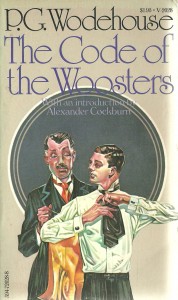P.G. Wodehouse’s The Code of the Woosters; the funniest n. in the E. language

How do you convince someone that The Code of the Woosters by P.G. Wodehouse, published in 1938, is the best comedic novel in the English language? And then how can you possibly think well of this person if they don’t confirm this assessment after reading it?
I think that’s always been a problem for Wodehouseans; we think so highly of Wodehouse and this story that any demurral can only brand that person as a complete and total fatheaded ass. In fact we are sometimes reluctant to reveal our love of Wodehouse to a new acquaintance, lest we find out that person cannot appreciate the genius of Fink-Nottles, newts, cow creamers, policemen’s helmets, nascent dictators and the mystery of Eulalie.
Despite the risk of disappointment, however, I will take a chance on you and do my best to acquaint you with Jeeves and Wooster and the aforementioned Fink-Nottle, newts, cow creamers, et al. To give some form and substance to my efforts, I should first try to organize my thoughts and give you a précis of the rum occurrences at Totleigh Towers.
Bertram Wooster, that fashionable young man about town, is nursing a hangover after hosting a bachelor party for his friend and newt fancier Gussie Fink-Nottle. His interest in his friend’s impending nuptials is not altogether altruistic because should Gussie return his fiancée, Madeleine Bassett, to store, Bertie is on the hook to marry her because of an earlier misunderstanding too complicated to enter into here.
Actually all of this is pretty complicated and to borrow a device from Wodehouse himself, if you’re already au courant with the doings at Totleigh Towers, you might skip the next several paragraphs. For those of you new to the story, let me just summarize the plot elements thusly:
Bertie’s Aunt Dahlia wants him to sneer at a cow creamer that her husband, Bertie’s Uncle Tom, wants desperately. But Sir Watkyn Bassett, a former London judge who not too long ago fined Bertie five quid for attempting the theft of a policeman’s helmet, also wants said creamer and through a series of misunderstandings at the silver shop, Sir Watkyn and his friend, the Black Shorts ringleader Roderick Spode, believe Bertie to be a thief.
Bassett pulls a fast one and manages to buy the cow creamer right from under the nose of Uncle Tom, and Aunt Dahlia tries to persuades Bertie to go to Bassett’s home, Totleigh Towers, and steal it back. Aunt Dahlia needs to mollify her husband, lest he dig his heels at indulging in his wife’s literary extravagance, her journal Milady’s Boudoir. Bertie is loathe to go to Totleigh Towers, but he receives a telegram from Gussie that there is a rift in the lute twixt Gussie and Madeleine. So Bertie cadges an invitation from Madeleine and travels to Totleigh Towers in hopes of effecting a rapprochement between Madeleine and Gussie.
Madeleine, however, thinks Bertie still hopes that Madeleine might marry him, which is opposite to Bertie’s foreign policy. Madeleine’s belief that “every time a fairy blows its wee nose a baby is born” and that the stars are God’s daisy chain fills Bertie with an unspeakable horror, despite Madeleine being undeniably pretty.
Nevertheless, Bertie undertakes the task of reconciling Madeleine and Gussie and along the way navigates a missing notebook; the dog Bartholomew and his owner, the mercurial Stephanie Byng; Constable Oates and his missing helmet; the lovable oaf the Rev. Stinker Pinker; and the mystery of Eulalie, which I leave a mystery.
Fortunately, Bertie has the help of his valet, Jeeves, a master of the trouser crease and a master reasoner who has kept Bertie from landing in the soup on numerous occasions. But even Jeeves is often stumped dealing with the den of iniquity and skullduggery known as Totleigh Towers.
